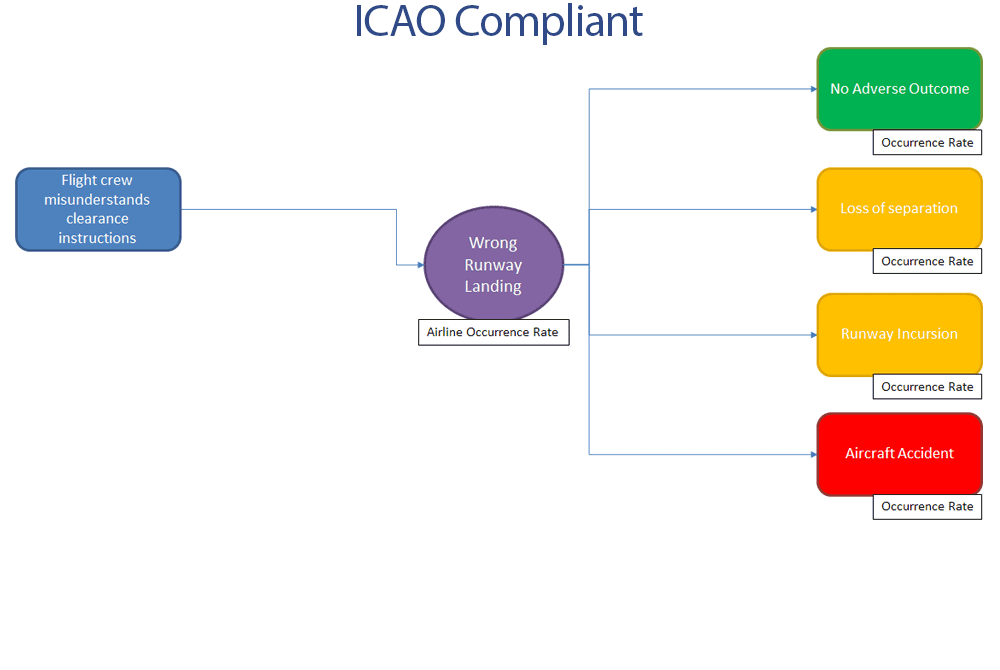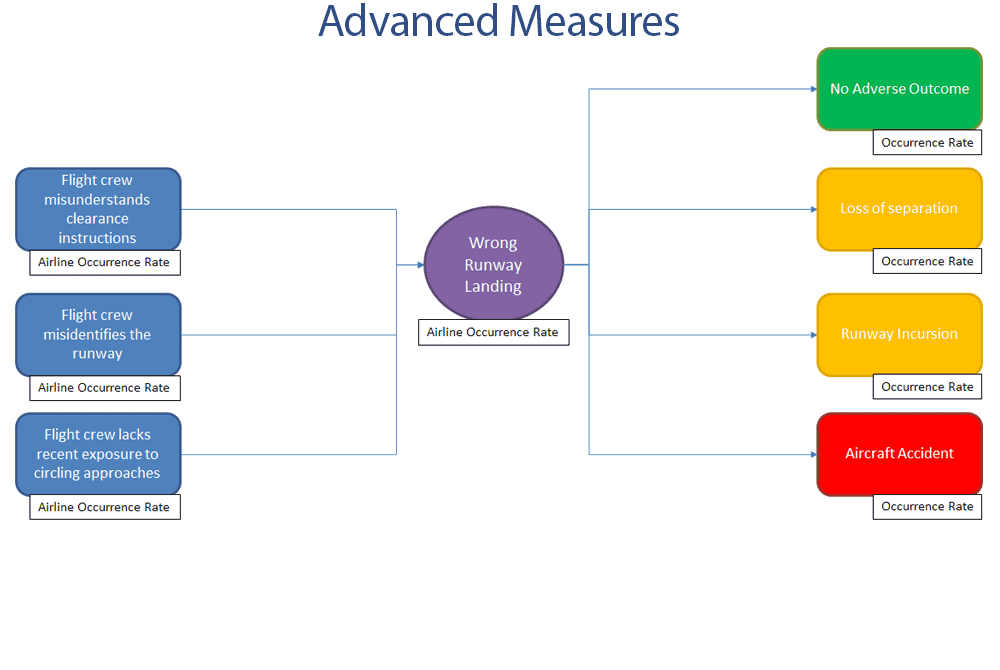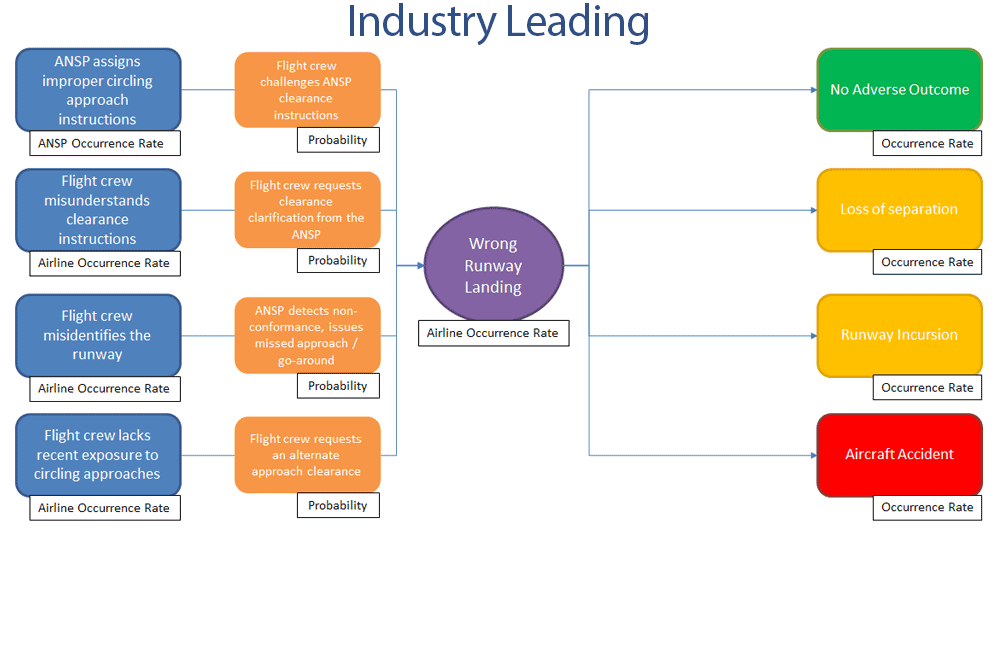The GSIP Toolkit are currently under development and is not final.
Feedback may be submitted at the bottom of each page.

Data Analysis & Processing
The process and methods for evaluating and interpreting the data collected to identify operational and safety needs and to inform an organization/domain’s response.
Introduction
Translating large, complex sets of data into meaningful, actionable results, can be quite challenging. This may require an organization to condition data, apply advanced analytical techniques, or to depict results in innovative ways. Advanced models and data visualizations are one way to improve effective cross-organizational safety enhancements. Data Analysis & Processing aims to provide stakeholders with increased awareness of tools, resources, methods, and processes to improve the identification of:
Safety event trends and patterns
Cross-cutting causal factors impacting performance
Recurring human errors
Emerging operational safety risks
Effective safety enhancement initiatives
Data Analysis Types
There are many different types of safety analyses utilized across the aviation industry. Some analysis techniques are easily adoptable utilizing the safety data already being collected by most organizations. Other more advanced analysis techniques may require new or modified data collection mechanisms. Provided below are example analysis types that may each provide unique insights to an aviation analyst.
Frequency-based Analysis

Many safety analyses begin with frequency-based assessments of safety data. Summarizing the most frequently occurring hazards or safety event types provides an organization with a way to rank and prioritize safety issues. For example, an air carrier may track and monitor the number of high energy landings across different airports, approaches, or aircraft types. Analysts can then monitor high energy landing events across their operation and identify reoccurring patterns and trends. Results of frequency-based assessments will typically lead to ranked listings of top hazards and the identification of prioritized issues that require further analysis.
The Aviation Safety Information Analysis and Sharing (ASIAS) system enables users to perform integrated queries of multiple databases, search an extensive warehouse of safety data, and display pertinent elements in an array of useful formats.
Flight Safety Foundation maintains an interactive web-based tool that permits users to review and tailor aircraft accident data, such as frequency and trends.
ICAO annually publishes a safety report to document global policy and standardization initiatives, the status of monitored KPIs, current safety analyses, and the status changes to address safety needs.
IATA published an annual report detailing accident analysis trends. This information aims to provide insight into cross-cutting risks and potential mitigations.
FAA report detailing the cause of general aviation maintenance related accidents between 1988 and 1997. This report documents the frequency of occurrence, and focuses on top causal factors.
Statistical Summary of Commercial Jet Airplane Accidents – Worldwide Operations | 1959 – 2014 provides analyses of commercial jet airplane accidents, causes, and related information and statistics.
The Australian Transport Safety Bureau publishes a wide range of materials relating to transport safety. This link provides information on all ATSB non-investigation report publications.
Airbus annually publishes a brochure that highlights the evolution of aviation safety through worldwide accident rates, frequencies, and trends.
The FAA maintains an interactive database that contains completed and active accident and incident investigation data.
Bowtie Analysis

A Bowtie analysis is a method that enables analysts to graphically document the risks and barriers associated with hazards and adverse events. Central to the bowtie diagram is a Top Event that represents the outcome of a hazard facing a system, such as a Wrong Runway Landing l Expanding to the left of the Top Event are the series of Threats that could lead to the occurrence of the Top Event. Expanding to the right of the Top Event are the various Consequences resulting from the Top Event, such as runway incursion. Supplementing the Threats and Consequences are the Control and Recovery Barriers that reduce the impact of the Threats and minimize the Consequences of those Barriers.
The primary benefits of a Bowtie analysis are the ability to visualize multiple plausible scenarios in single place. More advanced Bowtie applications may include probabilities and rates to support advanced safety modeling applications. Industry driving bowtie analyses typically include multiple types of threats from different domains and stakeholders.
A collection of robust bowtie examples developed by the UK Civil Aviation Authority. The example bowties include multiple scenarios for different types of aviation risks.
The UK CAA provides detailed information on the bowtie method, how-to examples for new users, templates, and other valuable safety guidance materials.
The UK Ministry of Defense and the UK Military Aviation Authority are jointly trialing the bowtie method. This site provides insight into their use of bowties along with sample bowtie products.
Guidance materials developed by the European Commercial Aviation Safety Team (ECAST) explore the safety risk assessment portion of SMS. This document includes the bowtie method and diagrams.
SKYbrary provides an overview of the bowtie methodology. Additionally, the article includes links to related articles on Hazard Identification, Risk Assessment, and Risk Management.
A conference paper titled "Lessons Learned from Real World Application of the Bow-tie Method" provides insights into the practical application and benefits of utilizing bowties.
2D & 3D Hotspot Analysis

Hotspot Analysis provides a way to visualize safety data that includes a 2D or 3D geographic component to support proactive risk assessment. Typically Hotspots are identified by highlighting the overlapping, or most frequently occurring, geographic data elements. For example, an airport operator, regulator, or ANSP may plot all runway incursions at a given airport onto an airport diagram. The areas with the most frequently occurring runway incursions may then be highlighted and designated as surface hotspots. The information can then be utilized to enhance pilot and air traffic controller situation awareness related to improving runway safety. More advanced Hotspot analyses may utilize Flight Data Monitoring to develop 3D Hotspots highlighting geographic regions with the most frequently occurring TCAS Resolution Advisories or Ground Proximity Warnings.
This listing of airport hotspots identifies locations on an airport movement area with a history of potential risk of collision or runway incursion, and where heightened attention by pilots and drivers is necessary.
The Aviation Safety Information Analysis and Sharing (ASIAS) system enables users to perform integrated queries of multiple databases, search an extensive warehouse of safety data, and display pertinent elements in an array of useful formats.
A review of common hotspot mapping techniques in non-aviation applications provided by University College London.
Causal Factor Analysis

Accidents, incidents, and other safety events rarely occur in isolation. In many cases, the resulting safety event is the result of a series of causal and contributory factors that influenced the resulting safety event. A Causal Factors analysis aims to identify, classify, analyze, and mitigate the presence of factors adversely impacting safe operations.
Most Causal Factor analyses begin with the development or modification of a causal factor taxonomy that outlines the latent and active factors present in a domain. The taxonomy can then be used to inform the collection of safety data from employee voluntary safety reports, safety investigations, and safety assurance data. At the more advanced safety analysis levels, trend analyses can be conducted to identify and prioritize the factors that introduce negative and positive impacts to operational safety.
The CAST / ICAO Common Taxonomy Team is developing common taxonomies and definitions for aviation accident and incident reporting systems.
The Air Traffic Analysis and Classification System (AirTracs) provides a standardized taxonomy for analyzing the factors impacting human performance related to air traffic management.
HFACS is a human error taxonomy and process that provides a structured approach for the investigation of both accidents and near-miss incidents. HFACS allows for the identification of broad causal factors across a domain.
The FAA developed this maintenance Aviation Safety Action Plan (ASAP) guide ro provide a simple, practical source of information regarding the development and assessment of ASAP programs for the aviation maintenance community.
Guidance materials developed by the European Commercial Aviation Safety Team (ECAST) explore the safety risk assessment portion of SMS. This document includes the bowtie method and diagrams.
EASA works to ensure civil aviation safety, through certification of aviation products, approval of organizations to provide aviation services, development and implementation of a standardized European regulatory framework.
The Service Integrity Risk Analysis Process (SI-RAP) taxonomy provides a taxonomy of factors impacting service integrity events. This report details the methodology for developing the SI-RAP taxonomy.
States have access to the ADREP system, which is operated and maintained by ICAO. This interactive database collects occurrence data (accident / incident), and provides users with the ability to exchange safety information.
The HERA-JANUS technique is a taxonomy and process that examines, in detail, the human factors causal factors associated with ATC safety events. HERA-JANUS allows for the identification of multiple (detailed) causal factors.
Comparative Analysis

Organizations interested in maintaining consistent performance improvement may engage in Comparative Analyses. Comparative Analysis, also known as benchmark analysis, involves the direct or indirect comparison of operational performance against comparable safety data sets. Comparisons may be made either internally against a company's historical performance or externally against a comparable set of industry performance data. Comparing operational safety data against other performance data enables an organization to identify irregularities and opportunities for improvement. External comparative analysis requires access to related data through data exchanges or pooled data sets. More advanced comparative analysis can be utilized to facilitate industry-wide focused safety improvement workshops and improvement initiatives.
The Aviation Safety Information Analysis and Sharing (ASIAS) system enables users to perform integrated queries of multiple databases, search an extensive warehouse of safety data, and display pertinent elements in an array of useful formats.
CANSO developed 21 recommended key performance indicators for measuring ATM operational performance. These KPIs span all phases of flight and allow ANSPs to monitor specific parts of their system, and identify opportunities for improvement.
The FAA and EUROCONTROL conducted a comparative analysis of ATM performance using a set of harmonized KPIs. This assessment identified opportunities for each Agency to optimize operational performance.
The Air Traffic Analysis and Classification System (AirTracs) provides a standardized taxonomy for analyzing the factors impacting human performance related to air traffic management.
ICAO annually publishes a safety report to document global policy and standardization initiatives, the status of monitored KPIs, current safety analyses, and the status changes to address safety needs.
Providing up-to-date, complete and reliable authoritative information on airliner accidents and safety issues
FAA report detailing the cause of general aviation maintenance related accidents between 1988 and 1997. This report documents the frequency of occurrence, and focuses on top causal factors.
HFACS is a human error taxonomy and process that provides a structured approach for the investigation of both accidents and near-miss incidents. HFACS allows for the identification of broad causal factors across a domain.
Flight Operational Quality Assurance (FOQA) is a voluntary safety program that is designed to make commercial aviation safer by allowing commercial airlines and pilots to share de-identified aggregate information with the FAA
The principles of aviation safety management laid down in the SSP serve as a basis for the development of safety management systems (SMS).
IATA FDX provides an example of third party flight data exchange service that provides stakeholders with an understanding of domain-specific and systemic safety needs.
STEADES provides an example of third party services that allows users to submit and securely retrieve information to inform the development of performance targets.
The FAA maintains an interactive database that contains completed and active accident and incident investigation data.
The HERA-JANUS technique is a taxonomy and process that examines, in detail, the human factors causal factors associated with ATC safety events. HERA-JANUS allows for the identification of multiple (detailed) causal factors.
The US Department of Transportation provided a summary of 2014 aviation traffic data. This data can inform systemic performance changes over time.
Data Analysis & Processing Levels
An organization may choose the level of intensity appropriate for analyzing operational safety based on the organization's capabilities and the significance of the hazard being assessed. Additionally, the levels of intensity allow an organization to identify opportunities to enhance data analysis & processing techniques and effectiveness to support thorough and accurate analyses and products.
| ICAO Compliant | Advanced Measures | Industry Leading | Industry Driving |
|---|---|---|---|
| Data is assessed against the notion of a single specific hazard and whether risk is above acceptable levels—mitigation assignments are made. | Data is analyzed to understand all direct hazards and their impact on undesired outcomes. Multiple hazards are each examined for their influence on risk. | Data is analyzed to understand all direct and indirect hazards and their impact on undesired outcomes. Multiple hazards are each examined for their influence on risk. | Data is analyzed to understand all industry impacts on safety. Multiple hazards are each examined for their influence on risk. Multiple organizations are contributing analysis to the risk assessment. |
Data Analysis Assumptions
All capabilities are independent of each other
Sources of data include: Public Safety Data, Reportable Occurrences, Safety Program Information
Domain capabilities are additive to the preceding domain capabilities (e.g., Industry Leading Capabilities assumes achievement of Minimum Compliance and Advanced Measures)
Example Application
The example below demonstrates the increasing levels of intensity applied to an analysis of the risk of wrong runway landings.

Airline identifies wrong runway event occurrence rates, and outcome rates. While airlines may identify factors involved in individual events, the aggregated data analysis focuses on tracking wrong runway landing events and the outcomes of those events.

Airline expands to track all known factors which may impact an airlines risks of a wrong runway landing. Occurrence rate of these factors are measured and tracked across airline operations.

Airline expands hazard tracking to include outside factors such as ANSP assigning incorrect approach instructions. At the industry leading level, the airline begins to include safety barriers to limit the impact of factors leading to wrong runway landings. The Airline will incorporate operational data and advanced modeling to estimate the probability of success of the barriers.

At the highest level of intensity, factor occurrence rates expand to include data from other airlines to provide a broader risk picture. Additionally, an airline utilizes operational data to model the impact of barriers to mitigate the effects of wrong runway landings. This level provides a complete risk picture of wrong runway landings including incorporating shared or pooled data from across the industry.
Resources and Examples
A collection of resources related to aviation data analysis and processing are provided below. Click any example for more information.
A collection of robust bowtie examples developed by the UK Civil Aviation Authority. The example bowties include multiple scenarios for different types of aviation risks.
This listing of airport hotspots identifies locations on an airport movement area with a history of potential risk of collision or runway incursion, and where heightened attention by pilots and drivers is necessary.
The Aviation Safety Information Analysis and Sharing (ASIAS) system enables users to perform integrated queries of multiple databases, search an extensive warehouse of safety data, and display pertinent elements in an array of useful formats.
The CAST / ICAO Common Taxonomy Team is developing common taxonomies and definitions for aviation accident and incident reporting systems.
CANSO developed 21 recommended key performance indicators for measuring ATM operational performance. These KPIs span all phases of flight and allow ANSPs to monitor specific parts of their system, and identify opportunities for improvement.
The UK CAA provides detailed information on the bowtie method, how-to examples for new users, templates, and other valuable safety guidance materials.
The UK Ministry of Defense and the UK Military Aviation Authority are jointly trialing the bowtie method. This site provides insight into their use of bowties along with sample bowtie products.
Flight Safety Foundation maintains an interactive web-based tool that permits users to review and tailor aircraft accident data, such as frequency and trends.
The FAA and EUROCONTROL conducted a comparative analysis of ATM performance using a set of harmonized KPIs. This assessment identified opportunities for each Agency to optimize operational performance.
The Air Traffic Analysis and Classification System (AirTracs) provides a standardized taxonomy for analyzing the factors impacting human performance related to air traffic management.
ICAO annually publishes a safety report to document global policy and standardization initiatives, the status of monitored KPIs, current safety analyses, and the status changes to address safety needs.
IATA published an annual report detailing accident analysis trends. This information aims to provide insight into cross-cutting risks and potential mitigations.
Providing up-to-date, complete and reliable authoritative information on airliner accidents and safety issues
FAA report detailing the cause of general aviation maintenance related accidents between 1988 and 1997. This report documents the frequency of occurrence, and focuses on top causal factors.
HFACS is a human error taxonomy and process that provides a structured approach for the investigation of both accidents and near-miss incidents. HFACS allows for the identification of broad causal factors across a domain.
The FAA developed this maintenance Aviation Safety Action Plan (ASAP) guide ro provide a simple, practical source of information regarding the development and assessment of ASAP programs for the aviation maintenance community.
Flight Operational Quality Assurance (FOQA) is a voluntary safety program that is designed to make commercial aviation safer by allowing commercial airlines and pilots to share de-identified aggregate information with the FAA
Guidance materials developed by the European Commercial Aviation Safety Team (ECAST) explore the safety risk assessment portion of SMS. This document includes the bowtie method and diagrams.
EASA works to ensure civil aviation safety, through certification of aviation products, approval of organizations to provide aviation services, development and implementation of a standardized European regulatory framework.
Statistical Summary of Commercial Jet Airplane Accidents – Worldwide Operations | 1959 – 2014 provides analyses of commercial jet airplane accidents, causes, and related information and statistics.
The principles of aviation safety management laid down in the SSP serve as a basis for the development of safety management systems (SMS).
The Service Integrity Risk Analysis Process (SI-RAP) taxonomy provides a taxonomy of factors impacting service integrity events. This report details the methodology for developing the SI-RAP taxonomy.
The Australian Transport Safety Bureau maintains an interactive database that contains completed and active accident and incident investigation data.
The Australian Transport Safety Bureau publishes a wide range of materials relating to transport safety. This link provides information on all ATSB non-investigation report publications.
Airbus annually publishes a brochure that highlights the evolution of aviation safety through worldwide accident rates, frequencies, and trends.
A review of common hotspot mapping techniques in non-aviation applications provided by University College London.
SKYbrary provides an overview of the bowtie methodology. Additionally, the article includes links to related articles on Hazard Identification, Risk Assessment, and Risk Management.
States have access to the ADREP system, which is operated and maintained by ICAO. This interactive database collects occurrence data (accident / incident), and provides users with the ability to exchange safety information.
This link provides an example of third party flight data analysis services that can provide operators with valuable insight into emerging trends and issues before an accident or incident occurs.
IATA FDX provides an example of third party flight data exchange service that provides stakeholders with an understanding of domain-specific and systemic safety needs.
Feedback Requested
The Flight Safety Foundation requests your feedback will help us achieve one of the core objectives of GSIP – improve the sharing and harmonization of information. All aviation safety stakeholders are invited to submit toolkit feedback via either the link below or by adding a comment to this page. All feedback will be reviewed by the GSIP team to improve the overall quality of the product.







































